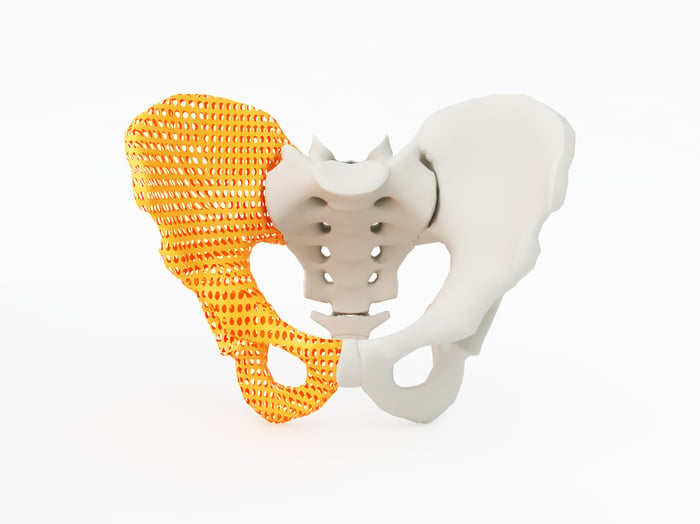Earlier this month, 3D Systems (DDD -1.15%) reported first-quarter 2021 results that easily beat the Wall Street consensus estimates for both revenue and earnings. The stock skyrocketed 35% the next day.
In the first quarter, the 3D printing company's revenue rose 7.7% year over year (and 17% excluding the impact of divestitures) to $146.1 million. Growth was driven by continued strength in the healthcare segment and a stabilizing of the industrial segment, which was hard hit by the fallout from the COVID-19 pandemic.
Moreover, the company posted a profit on both an adjusted basis and according to generally accepted accounting principles (GAAP). Adjusted for one-time items, net income landed at $20.9 million, or $0.17 per share, up from a loss per share of $4.5 million, or $0.04 per share, in the year-ago period. GAAP net income was $45.2 million, or $0.36 per share, up from a loss of $18.9 million, or $0.17 per share, in the first quarter of 2020.
Earnings releases tell only part of the story. Following are two key things from 3D Systems' Q1 earnings call that investors should know.

Image source: Getty Images.
1. The company's competitive advantages
From CEO Jeffrey Graves' remarks:
There are three things that inspire my confidence in our future. And I believe they should inspire yours as well. First, we clearly by far have the broadest technology portfolio in the industry. [...] Second, I'm convinced that we have the brightest and most creative application engineers in the industry. [...]
Third, as one of the largest and most experienced companies in the industry, we have the scale and the infrastructure to not only support our customers' needs when they initially implement additive manufacturing, but also sustain them over the lifetime of their equipment by providing key services and consumables that are vital to their ongoing business success.
As to Graves' first point, 3D Systems does have the broadest offerings in the 3D printing industry in terms of technology to my knowledge, at least among publicly traded companies. It has several polymer technologies and at least one metal 3D printing technology.
For a couple of points of comparison: Rival Stratasys (SSYS -1.11%), another well-established pure-play 3D printing company, doesn't have a metal 3D printing technology. Newly public Desktop Metal (DM -1.27%) is just in the early stages of commercializing its metal technology and only recently expanded into polymers via its February acquisition of EnvisionTEC.
His second point about having "the brightest and most creative application engineers" is too subjective to address.
I'll also agree with Graves' third point about 3D Systems having a scale and experience advantage, at least relative to most other players. That said, there's a caveat here. Under the prior two CEOs, the company prematurely released products that had quality issues. So, while scale does usually provide various advantages, it won't do so if customers are hesitant to buy a product from a company due to concerns about quality. Hopefully, this issue is largely behind 3D Systems, but investors still need to keep an eye on it.
2. Ramping up its healthcare business organically and through acquisitions
From Graves' remarks:
As you can see in our numbers for Q1, we're seeing rising demand for new applications, particularly in our healthcare business. To meet this demand forecast, we're expanding our Denver, Colorado, location by roughly 50%. [...] Through this next phase of investment [...] we'll be able to reduce time to market for new medical applications, continue expanding our product offerings, and better support the holistic needs of our growing healthcare customer base.
In Q1, 3D Systems' healthcare revenue surged 39% year over year to $72.5 million. This segment accounted for 49.6% of the company's total revenue of $146.1 million. So, its business is now essentially evenly split between healthcare and industrial.
As Graves said on the prior quarter's call, the company's healthcare business "brings a bit higher gross margin on average than our industrial business." So, naturally, it makes great sense to focus somewhat more on applications that are more profitable.
In addition, 3D Systems announced several days before it released its Q1 results that it had acquired Allevi, a small Philadelphia-based bioprinting company. Bioprinting refers to using 3D printing technology to print animal and human cells to produce three-dimensional, functional tissues. This was a smart move and expands the company's involvement in this space, as it's been collaborating with United Therapeutics (UTHR -0.44%) in this realm since 2017.
Graves said one key intermediate-term application of bioprinting is to help pharmaceutical companies speed up the drug development process. A longer-term goal of those working in this space is to print fully functional solid human organs such as the liver, heart, and kidneys for transplant purposes. Regenerative medicine, as it's often called, is in its infancy, but it has humongous growth potential.



